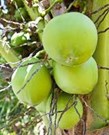Coconut has become the main industrial crop of Vietnam
On January 26, 2024, the Ministry of Agriculture and Rural Development of Vietnam issued a Decision approving the Project to develop key industrial crops until 2030 (including trees: coffee, rubber, tea). , cashew, pepper, coconut). Among them, there are coconut trees, with a strived output of 2.1 - 2.3 million tons by 2030, contributing to improving the value of export turnover of the agricultural, forestry and fishery industry, production efficiency and living standards. rural population and environmental protection.
Development Goals
According to the Decision of the Ministry of Agriculture and Rural Development of Vietnam, by 2030, the coconut area in the country will reach about 195 - 210 thousand hectares. The key coconut growing area in the Mekong Delta is about 170 - 175 thousand hectares, the South Central Coast area is 16 - 20 thousand hectares, the remaining 9 - 15 thousand hectares are grown in the provinces. North Central, Southeast... Transferring new coconut varieties into production such as green Siamese coconut, Malay coconut, pineapple coconut...
By 2030, over 30% of coconut area will be produced according to GAP and equivalent processes. The area of coconuts granted planting area codes is about 30%. Apply technical measures for intercropping (cocoa, fruit trees...), intercropping (aquaculture, poultry...) with coconut growing to increase value on production land area.
Combine the construction of coconut garden development space with garden and culinary eco-tourism, associated with the construction of local OCOP products. The Mekong Delta in the provinces (Ben Tre, Tra Vinh, Tien Giang, Vinh Long, Soc Trang...), the South Central Coast in the provinces (Binh Dinh, Quang Ngai, Khanh Hoa...). Develop craft villages, coconut production and processing facilities for tourism. Develop tourism programs to visit craft villages, visit coconut product manufacturing facilities, introduce production processes and activities; consume products on the spot.
Regarding processing activities, two product lines will be intensively developed, including: processed coconut and fresh coconut. Developing the coconut processing industry using advanced technology, diversifying products, focusing on rapidly increasing high value-added products and new products such as: coconut milk, coconut cream, coconut oil, fiber mats coconut, coconut fiber mattresses, handicraft products, canned coconut water...
Develop a system of shops selling handicrafts and specialty goods made from coconut. Training labor resources on making handicraft products from coconut, new equipment and technology, design, consumption markets... to proactively plan production and business of coconut products coconut.
Solution
The Ministry of Agriculture and Rural Development directs, based on the approved project, the provinces to identify key industrial crop production areas in the province's planning plan and related orientations. Review the area planted with key industrial crops on unsuitable and ineffective lands to convert crop structure, creating products with a higher value for the consumer market.
Localities continue to implement policies to attract businesses to invest in developing the production of key industrial crops, promoting the formation of production chains from building raw material areas to processing and consuming products. Cooperatives and cooperative groups are bridges connecting businesses with households growing key industrial crops.
For households, it is necessary to proactively link with businesses through cooperatives and cooperative groups to develop production material areas, carry out production according to GAP and equivalent processes, associated with code development. number of growing areas, product traceability...
Regarding science and technology, continue to invest in maintaining and storing existing genetic resources of key industrial plants, adding new genetic resources to serve scientific and technological research. Research, select, create and import new varieties of key industrial crops that are productive, high quality, resistant to pests and diseases, suitable for each ecological region, and adaptable to climate change conditions. Care and management of existing first-generation plants and first-generation gardens...
Develop and apply circular economy models. Investing in science and technology, modern equipment for deep processing, diversifying key industrial crop products, widely meeting domestic and international market needs.
For the domestic market, oriented to 2030, consumption of fresh coconut and about 20% of processed coconut. Localities and businesses need to build product brands, associated with geographical indications and planting area codes. Forming a product trading floor.
Regarding export, coordinate closely with ministries, branches, and industry associations on product promotion programs. Removing trade barriers, negotiating to expand export markets. Focus on some markets: Indonesia, Argentina... (for coconut oil products); EU, US, Japan, Korea... (coconut milk products, desiccated coconut products, canned coconut water); EU, South America, Asia... (activated carbon products, coconut fiber). As for fresh coconuts, aiming to export to the US, China, Japan, Korea, Australia, UAE markets...
Regarding state management, pay attention to organizing the good implementation of policies related to agriculture and rural areas. Research and transfer science and technology into production. Policies to promote mechanization of agricultural production and processing. Trade promotion, expanding product consumption markets...
Source: Dong Khoi Newspaper
https://baodongkhoi.vn/dua-tro-thanh-cay-cong-nghiep-chu-luc-02022024-a125791.html




















